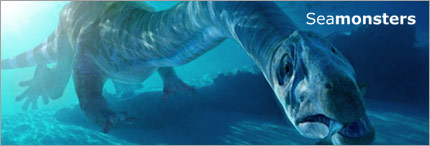Nutrition
Since the Tanystropheus longbardicus was an aquatic animal,
the main diet of this organism includes small fish, squid,
carrion and occasionally floating carcasses for other nutrition.
 Evidence of this comes from a long, narrow snout that has sharp
interlocking teeth (Facts about Tanystropheus n.d.). We can also
compare this to matching teeth patterns in
Eudimorphodon and
Langobardisaurus, both of whom were also fish eater (Facts about
Tanystropheus n.d.). Fish scales and parts of cephalopod
tentacles have been found near the belly region, which also
supports the fish diet (Facts about Tanystropheus n.d.). The
long necks become an advantage in hunting, because the predator
can closely approach prey before their whole body would become
apparent (Li et al. 2004). Contraction of the muscles of
the ribs would straighten the neck and cause the esophageal
volume to increase (Li et al. 2004). This increase in
the volume combined with a lunging of the neck would cause a
suctioning pressure and the organism would perform a perfect
strike to capture and eat its prey (Li et al. 2004).
T. longobardicus would also walk back and forth in the
shallow shorelines, using their long neck to look for prey just above the water line
(Renesto, S. 2005).
Evidence of this comes from a long, narrow snout that has sharp
interlocking teeth (Facts about Tanystropheus n.d.). We can also
compare this to matching teeth patterns in
Eudimorphodon and
Langobardisaurus, both of whom were also fish eater (Facts about
Tanystropheus n.d.). Fish scales and parts of cephalopod
tentacles have been found near the belly region, which also
supports the fish diet (Facts about Tanystropheus n.d.). The
long necks become an advantage in hunting, because the predator
can closely approach prey before their whole body would become
apparent (Li et al. 2004). Contraction of the muscles of
the ribs would straighten the neck and cause the esophageal
volume to increase (Li et al. 2004). This increase in
the volume combined with a lunging of the neck would cause a
suctioning pressure and the organism would perform a perfect
strike to capture and eat its prey (Li et al. 2004).
T. longobardicus would also walk back and forth in the
shallow shorelines, using their long neck to look for prey just above the water line
(Renesto, S. 2005).
 However, this theory has been thought of as
false due to the fact that T. longobardicus consumed
fish.
However, this theory has been thought of as
false due to the fact that T. longobardicus consumed
fish.